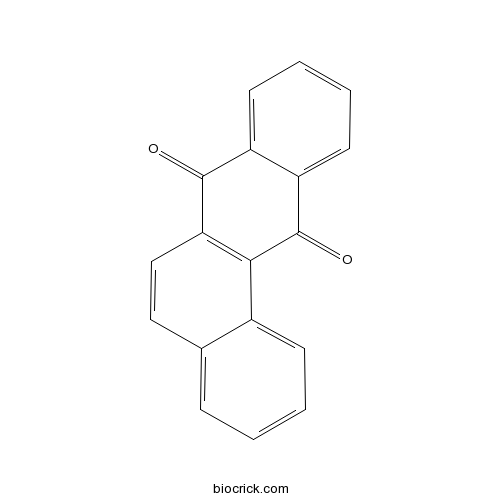1,2-BenzanthraquinoneCAS# 2498-66-0 |

Quality Control & MSDS
3D structure
Package In Stock
Number of papers citing our products

| Cas No. | 2498-66-0 | SDF | Download SDF |
| PubChem ID | 17253 | Appearance | Powder |
| Formula | C18H10O2 | M.Wt | 258.3 |
| Type of Compound | N/A | Storage | Desiccate at -20°C |
| Solubility | Soluble in Chloroform,Dichloromethane,Ethyl Acetate,DMSO,Acetone,etc. | ||
| Chemical Name | benzo[a]anthracene-7,12-dione | ||
| SMILES | C1=CC=C2C(=C1)C=CC3=C2C(=O)C4=CC=CC=C4C3=O | ||
| Standard InChIKey | LHMRXAIRPKSGDE-UHFFFAOYSA-N | ||
| Standard InChI | InChI=1S/C18H10O2/c19-17-13-7-3-4-8-14(13)18(20)16-12-6-2-1-5-11(12)9-10-15(16)17/h1-10H | ||
| General tips | For obtaining a higher solubility , please warm the tube at 37 ℃ and shake it in the ultrasonic bath for a while.Stock solution can be stored below -20℃ for several months. We recommend that you prepare and use the solution on the same day. However, if the test schedule requires, the stock solutions can be prepared in advance, and the stock solution must be sealed and stored below -20℃. In general, the stock solution can be kept for several months. Before use, we recommend that you leave the vial at room temperature for at least an hour before opening it. |
||
| About Packaging | 1. The packaging of the product may be reversed during transportation, cause the high purity compounds to adhere to the neck or cap of the vial.Take the vail out of its packaging and shake gently until the compounds fall to the bottom of the vial. 2. For liquid products, please centrifuge at 500xg to gather the liquid to the bottom of the vial. 3. Try to avoid loss or contamination during the experiment. |
||
| Shipping Condition | Packaging according to customer requirements(5mg, 10mg, 20mg and more). Ship via FedEx, DHL, UPS, EMS or other couriers with RT, or blue ice upon request. | ||

1,2-Benzanthraquinone Dilution Calculator

1,2-Benzanthraquinone Molarity Calculator
| 1 mg | 5 mg | 10 mg | 20 mg | 25 mg | |
| 1 mM | 3.8715 mL | 19.3573 mL | 38.7147 mL | 77.4293 mL | 96.7867 mL |
| 5 mM | 0.7743 mL | 3.8715 mL | 7.7429 mL | 15.4859 mL | 19.3573 mL |
| 10 mM | 0.3871 mL | 1.9357 mL | 3.8715 mL | 7.7429 mL | 9.6787 mL |
| 50 mM | 0.0774 mL | 0.3871 mL | 0.7743 mL | 1.5486 mL | 1.9357 mL |
| 100 mM | 0.0387 mL | 0.1936 mL | 0.3871 mL | 0.7743 mL | 0.9679 mL |
| * Note: If you are in the process of experiment, it's necessary to make the dilution ratios of the samples. The dilution data above is only for reference. Normally, it's can get a better solubility within lower of Concentrations. | |||||

Calcutta University

University of Minnesota

University of Maryland School of Medicine

University of Illinois at Chicago

The Ohio State University

University of Zurich

Harvard University

Colorado State University

Auburn University

Yale University

Worcester Polytechnic Institute

Washington State University

Stanford University

University of Leipzig

Universidade da Beira Interior

The Institute of Cancer Research

Heidelberg University

University of Amsterdam

University of Auckland

TsingHua University

The University of Michigan

Miami University

DRURY University

Jilin University

Fudan University

Wuhan University

Sun Yat-sen University

Universite de Paris

Deemed University

Auckland University

The University of Tokyo

Korea University
- 2beta-Hydroxygrandiflorenic acid
Catalog No.:BCN8447
CAS No.:24967-93-9
- NFAT Inhibitor
Catalog No.:BCC2463
CAS No.:249537-73-3
- Demethoxy-3-epifumitremorgin C
Catalog No.:BCC8315
CAS No.:106292-68-6
- Scutebarbatine N
Catalog No.:BCN8385
CAS No.:960302-87-8
- Poly(I:C)
Catalog No.:BCC6138
CAS No.:24939-03-5
- Varenicline
Catalog No.:BCC4155
CAS No.:249296-44-4
- Ethyl 3-cyclopropyl-3-oxopropanoate
Catalog No.:BCC8974
CAS No.:24922-02-9
- Sarracine
Catalog No.:BCN2021
CAS No.:2492-09-3
- beta-Isosparteine
Catalog No.:BCN2326
CAS No.:24915-04-6
- H-Ala-OMe.HCl
Catalog No.:BCC3192
CAS No.:2491-20-5
- H-Met-OMe. HCl
Catalog No.:BCC2995
CAS No.:2491-18-1
- Bakkenolide III
Catalog No.:BCN7245
CAS No.:24909-95-3
-
SB-334867 hydrochloride
Catalog No.:BCC4289
CAS No.:249889-64-3
- Borreriagenin
Catalog No.:BCN5115
CAS No.:249916-07-2
- Anamorelin
Catalog No.:BCC1362
CAS No.:249921-19-5
- Miriplatin hydrate
Catalog No.:BCC1751
CAS No.:250159-48-9
- 1,2:4,5-Di-O-isopropylidene-beta-D-fructopyranose
Catalog No.:BCN1475
CAS No.:25018-67-1
- Otophylloside F
Catalog No.:BCN6441
CAS No.:250217-73-3
- Boc-His(Dnp)-OH
Catalog No.:BCC3401
CAS No.:25024-53-7
- PNU 177864 hydrochloride
Catalog No.:BCC7664
CAS No.:250266-51-4
- Excavatin M
Catalog No.:BCN5116
CAS No.:250293-31-3
- (±)-Acetylcarnitine chloride
Catalog No.:BCC6617
CAS No.:2504-11-2
- Cyclo(RGDyK)
Catalog No.:BCC6512
CAS No.:250612-42-1
- Pedunsaponin A
Catalog No.:BCN8192
CAS No.:250613-27-5
Photoreduction of 9,10-anthraquinone derivatives: transient spectroscopy and effects of alcohols and amines on reactivity in solution.[Pubmed:12785056]
Photochem Photobiol. 2003 Feb;77(2):171-9.
The photoreduction of 9,10-anthraquinone (AQ), the 2-methyl, 2-ethyl, 2,3-dimethyl, 1,4-difluoro, 1-chloro and 1,8-dichloro derivatives as well as 1,4,4a,9a-tetrahydroanthraquinone, 1,2-Benzanthraquinone and 6,13-pentacenequinone in nonaqueous solution at room temperature was studied by time-resolved UV-visible spectroscopy. Upon 308 nm excitation of AQ the triplet state reacts with alcohols and triethylamine (TEA). The rate constant of triplet quenching by amines is close to the diffusion-controlled limit. The semiquinone radical *QH/ Q*- is the main intermediate, and the half-life of the second-order decay kinetics depends significantly on the donor and the medium. Photoinduced charge separation after electron transfer from amines to the triplet state of AQ in acetonitrile and the subsequent charge recombination or neutralization also were measured by transient conductivity. The maximum quantum yield, lambdairr = 254 nm, of photoconversion into the strongly fluorescing 9,10-dihydroxyanthracenes is close to unity. The fluorescence with maximum at 460-480 nm and a lifetime of 20-30 ns disappears as a result of a complete recovery into AQ, when the dihydroxyanthracenes are exposed to oxygen. The mechanisms of photoreduction of parent AQ in acetonitrile by 2-propanol and in benzene and acetonitrile by TEA are discussed. The effects of AQ follow essentially the same pattern. The various functions of oxygen, e.g. (1) quenching of the triplet state; (2) quenching of the semiquinone radical, thereby forming HO2*/O2*- radicals; and (3) trapping of the dihydroxyanthracenes are outlined.


